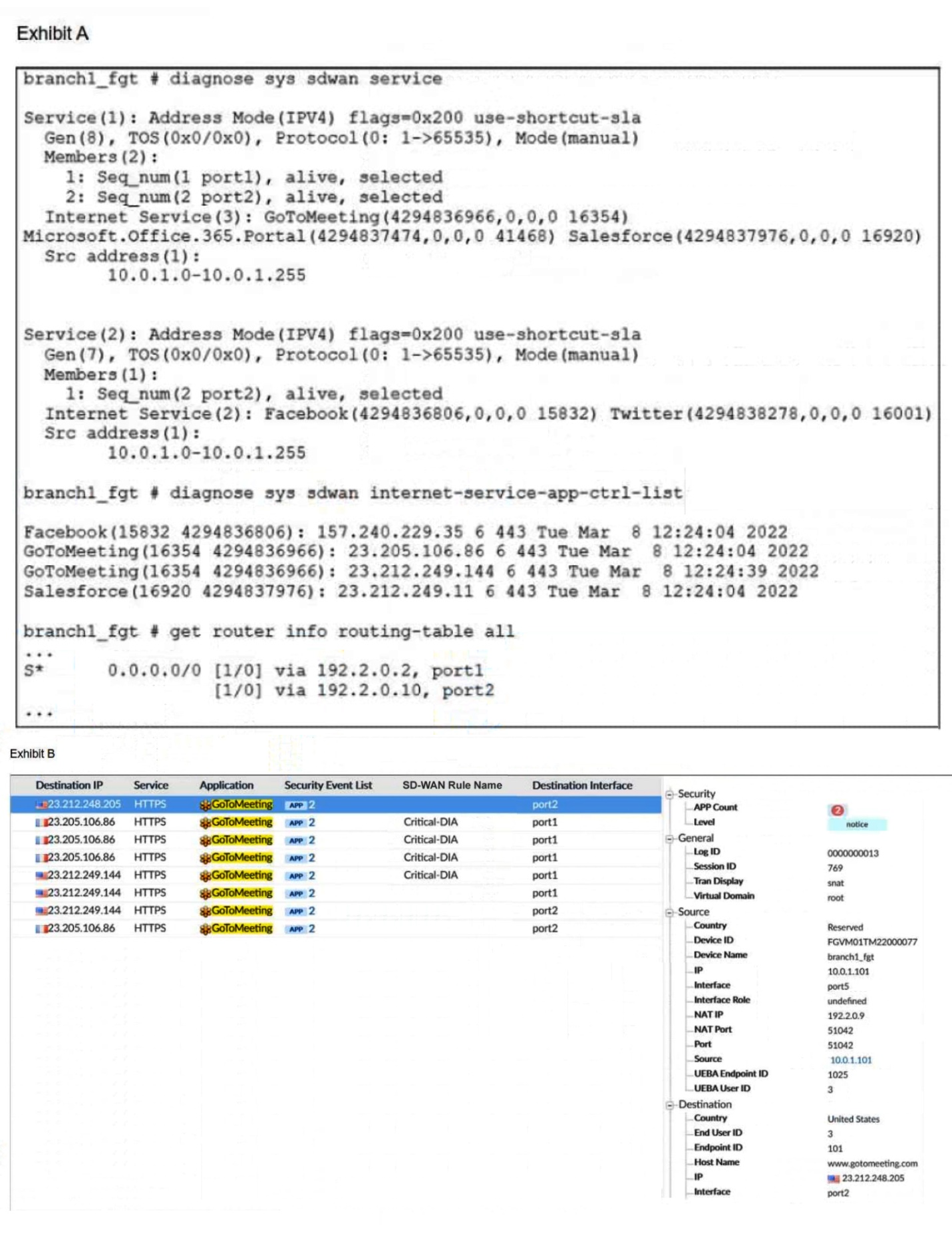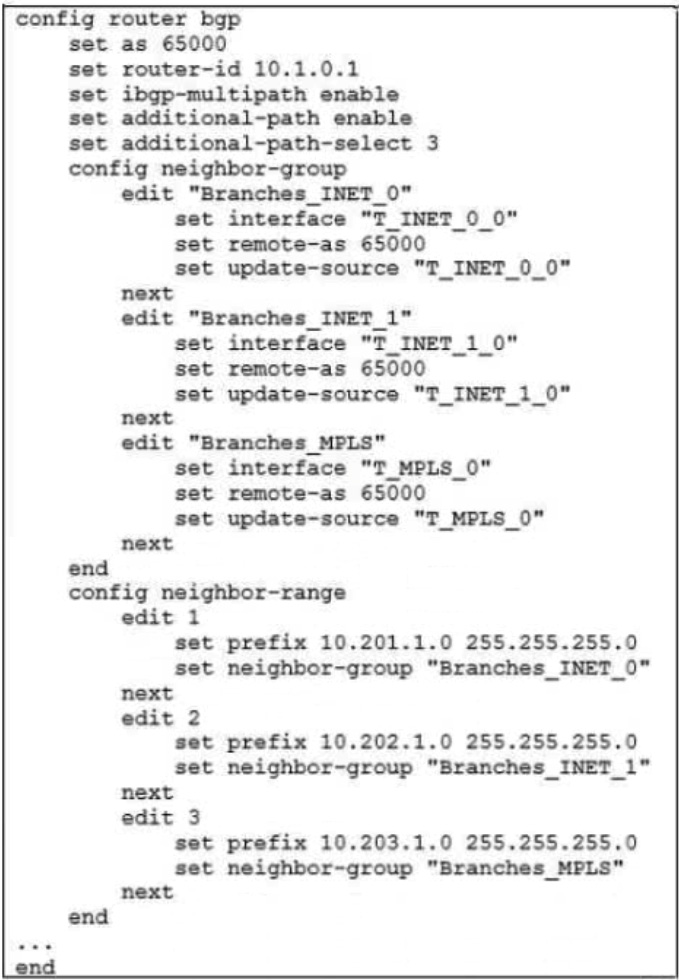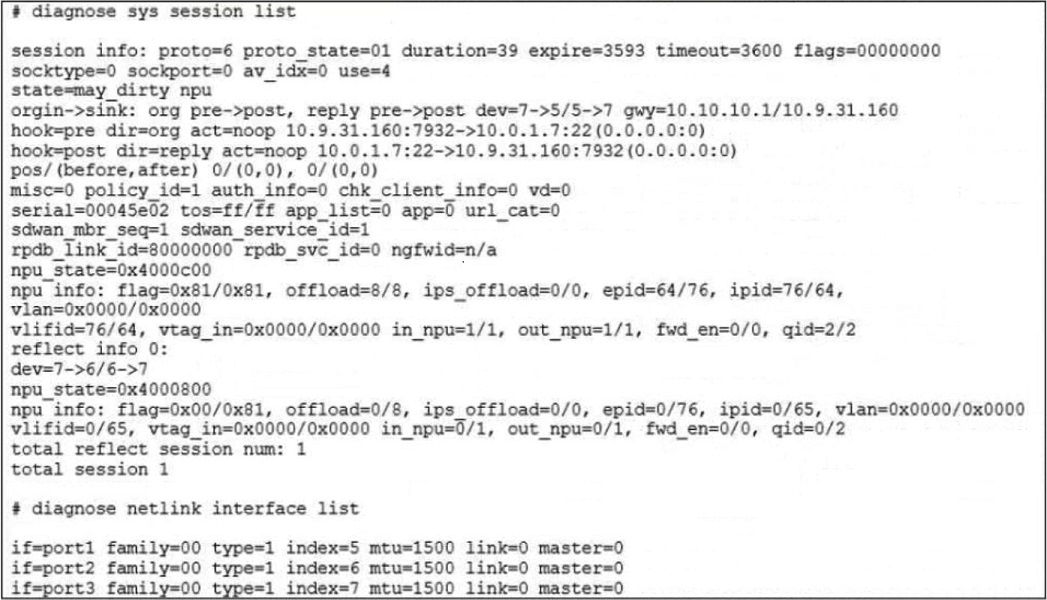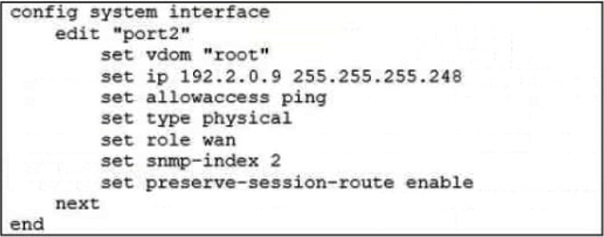Question 41
Refer to the exhibits.
An administrator is testing application steering in SD-WAN. Before generating test traffic, the administrator collected the information shown in exhibit A.
After generating GoToMeeting test traffic, the administrator examined the respective traffic log on FortiAnalyzer, which is shown in exhibit B. The administrator noticed that the traffic matched the implicit SD-WAN rule, but they expected the traffic to match rule ID 1.
Which two reasons explain why the traffic matched the implicit SD-WAN rule? (Choose two.)

A. FortiGate did not refresh the routing information on the session after the application was detected.
B. Port1 and port2 do not have a valid route to the destination.
C. Full SSL inspection is not enabled on the matching firewall policy.
D. The session 3-tuple did not match any of the existing entries in the ISDB application cache.
Question 42
Which two statements are true about using SD-WAN to steer local-out traffic? (Choose two.)
A. FortiGate does not consider the source address of the packet when matching an SD-WAN rule for local-out traffic.
B. By default, local-out traffic does not use SD-WAN.
C. By default, FortiGate does not check if the selected member has a valid route to the destination.
D. You must configure each local-out feature individually, to use SD-WAN.
Question 43
Refer to the exhibit.
The exhibit shows the BGP configuration on the hub in a hub-and-spoke topology. The administrator wants BGP to advertise prefixes from spokes to other spokes over the IPsec overlays, including additional paths. However, when looking at the spoke routing table, the administrator does not see the prefixes from other spokes and the additional paths.
Based on the exhibit, which three settings must the administrator configure inside each BGP neighbor group so spokes can learn other spokes prefixes and their additional paths? (Choose three.)

A. Set additional-path to send
B. Enable route-reflector-client
C. Set advertisement-interval to the number of additional paths to advertise
D. Set adv-additional-path to the number of additional paths to advertise
E. Enable soft-reconfiguration
Question 44
Refer to the exhibit.
The exhibit shows the details of a session and the index numbers of some relevant interfaces on a FortiGate appliance that supports hardware offloading. Based on the information shown in the exhibits, which two statements about the session are true? (Choose two.)

A. The reply direction of the asymmetric traffic flows from port2 to port3.
B. The auxiliary session can be offloaded to hardware.
C. The original direction of the symmetric traffic flows from port3 to port2.
D. The main session cannot be offloaded to hardware.
Question 45
Refer to the exhibit.
In a dual-hub hub-and-spoke SD-WAN deployment, which is a benefit of disabling the anti-replay setting on the hubs?

A. It instructs the hub to disable the reordering of TCP packets on behalf of the receiver, to improve performance.
B. It instructs the hub to disable TCP sequence number check, which is required for TCP sessions originated from spokes to fail over back and forth between the hubs.
C. It instructs the hub to not check the ESP sequence numbers on IPsec traffic, to improve performance.
D. It instructs the hub to skip content inspection on TCP traffic, to improve performance.
Question 46
Which SD-WAN setting enables FortiGate to delay the recovery of ADVPN shortcuts?
A. hold-down-time
B. link-down-failover
C. auto-discovery-shortcuts
D. idle-timeout
Question 47
Refer to the exhibit.
Which statement about the role of the ADVPN device in handling traffic is true?

A. This is a spoke that has received a query from a remote hub and has forwarded the response to its hub.
B. Two hubs, 10.0.1.101 and 10.0.2.101, are receiving and forwarding queries between each other.
C. This is a hub that has received a query from a spoke and has forwarded it to another spoke.
D. Two spokes, 192.2.0.1 and 10.0.2.101, forward their queries to their hubs.
Question 48
Refer to the exhibit.
Based on the exhibit, which two actions does FortiGate perform on traffic passing through port2? (Choose two.)

A. FortiGate does not change the routing information on existing sessions that use a valid gateway, after a route change.
B. FortiGate performs routing lookups for new sessions only, after a route change.
C. FortiGate always blocks all traffic, after a route change.
D. FortiGate flushes all routing information from the session table, after a route change.
Question 49
Which two statements about the SD-WAN zone configuration are true? (Choose two.)
A. The service-sla-tie-break setting enables you to configure preferred member selection based on the best route to the destination.
B. You can delete the default zones.
C. The default zones are virtual-wan-link and SASE.
D. An SD-WAN member can belong to two or more zones.
Question 50
What are two common use cases for remote internet access (RIA)? (Choose two.)
A. Provide direct internet access on spokes
B. Provide internet access through the hub
C. Centralize security inspection on the hub
D. Provide thorough inspection on spokes





